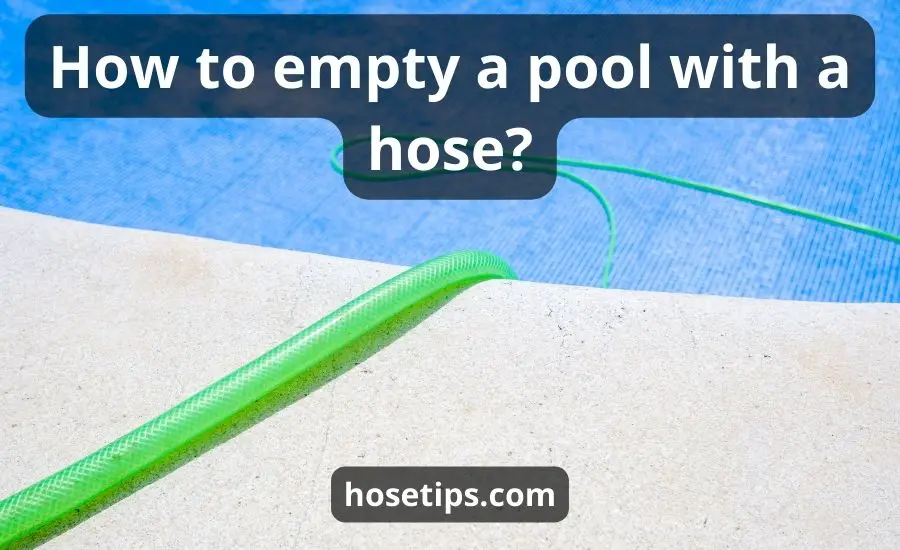Table of Contents
Wondering how to empty a pool with a hose? So the summer pool party season is over and it’s time to close up the pool for the year. You’ve got the cover ready to go, but there’s still the issue of draining all that pool water.
Before you call in an expensive pool service or rent a pump to empty it, save yourself the time, money, and hassle. All you need is a garden hose to empty your pool efficiently on your own.
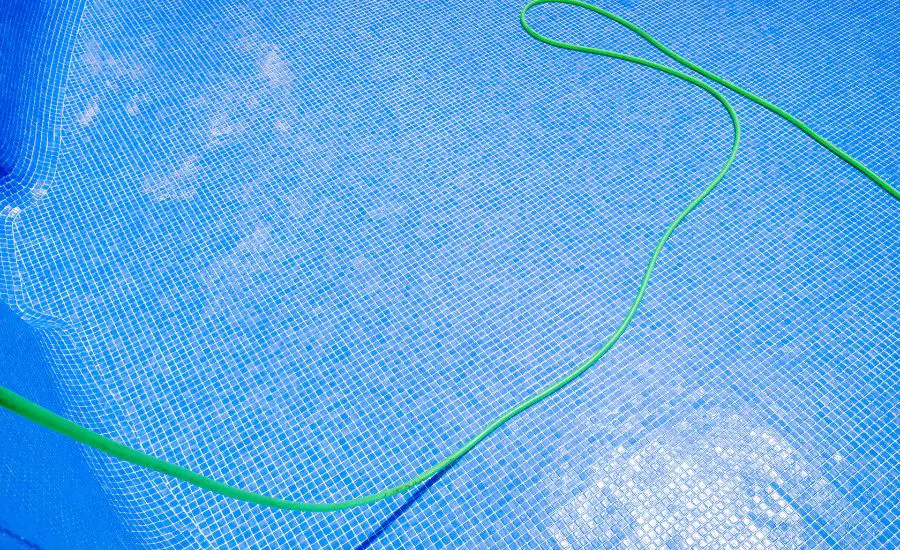
Garden hose siphon method
Why deal with the hassle of dragging out the pool pump when you can drain an above-ground pool
The easiest way is just with a garden hose
- It’s inexpensive and convenient
All you need is a standard garden hose to siphon the water out of your swimming pool. No expensive pumps, hoses, or other equipment are required. Just attach the hose to your spigot, put the other end in the pool, and turn on the water.
The siphoning action will start drawing pool water through the hose and out of your swimming pool.
- Gentler on your pool
Pumps can be harsh on your plumbing system, pool liner, or concrete surface. The strong suction can dislodge tiles or tear pool liner. To drain an above-ground pool with a hose is a slower, gentler process that avoids these issues. The water will empty at a controlled rate that won’t damage your pool liner.
- Environmentally friendly
Using a hose instead of a submersible pump to empty your swimming pool is easier on the environment. Pumps require electricity or gas to run, which increases your carbon footprint. A hose only uses the water that’s already running through your spigot, so it’s a more eco-friendly method to drain a pool.
To drain an above-ground pool with a hose, may take longer than using a submersible pump, but for a small to mid-size ground pool, it can get the job done overnight.
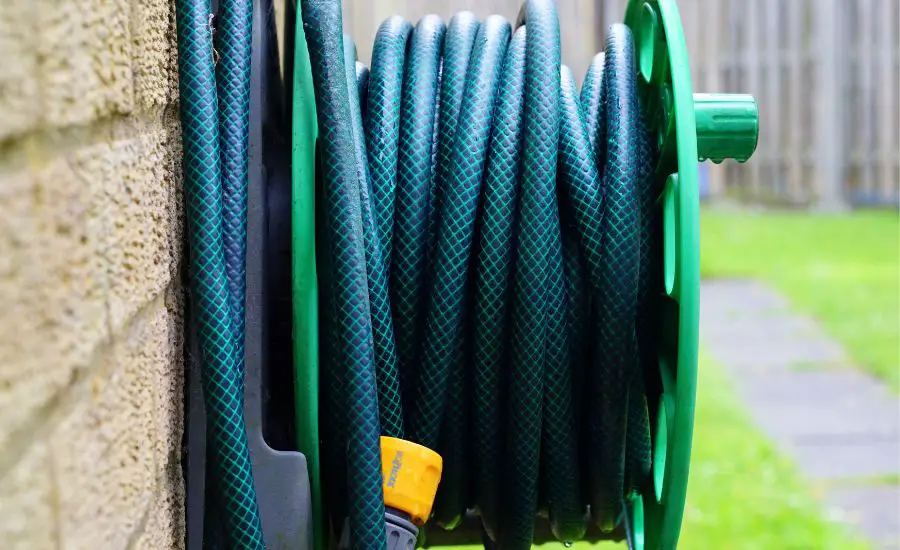
Calculate how long it will take
Figuring out how long it will take to completely drain a pool is important for planning. You don’t want the water running all night or during the hottest part of the day.
The time required depends on a few factors:
- Pool size
The larger the ground pool, the more gallons it holds and the longer it will take to empty. An average-sized inground pool of about 15,000 gallons could take 6-12 hours to drain completely. To drain an above-ground pool of 5,000-10,000 gallons may only take 3-6 hours. However, pool owners with bigger pools might need more equipment.
- Hose diameter
Using a larger hose, like 1 1⁄2 or 2 inches in diameter, will speed the pool pop-up draining versus a standard garden hose. The bigger the hose, the more pool water it can carry out of the above-ground pool at once.
Draining the inground pool takes a bit more time and patience, but it will be worth it to avoid pool pop.
- Water pressure
The water pressure in your area also affects draining time. Higher pressure means more force pushing the pool water through the hose, so it empties faster. Most municipal water supplies provide 40 to 60 psi of pressure which should work to drain an above-ground pool with a large diameter hose.
- Slope and obstacles
Any slopes in the hose’s path or obstacles like bushes, fences, or walls that the hose has to go over or around will slow the flow and increase draining time. Lay the hose as straight and flat as possible from the above-ground pool to the discharge area.
With the right-sized hose for above above-ground pool, adequate water pressure, and a clear path, you can safely estimate how long it should take to empty above above-ground pool to plan accordingly.
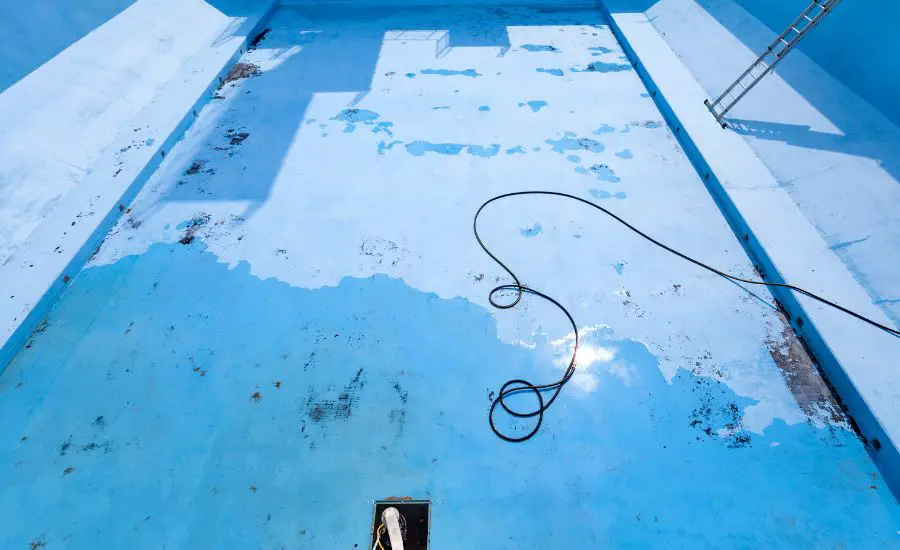
Choose the right type of hose
To empty the inground pool efficiently without a pump, you’ll want to choose a hose that can handle the job. Not just any old garden hose will do — you’ll need one specifically designed for transferring large volumes of water.
- Reinforced hose
When emptying an inground pool, it’s best to use a reinforced hose. These hoses feature added layers of protection, such as mesh or double-rubber lining, which enhance their durability and reduce the risk of kinking or bursting under pressure.
- Heavy-duty hose
A heavy-duty hose, also known as a contractor’s hose, is another good option. These hoses are made of high-quality, abrasion-resistant materials and are built to take a beating. They tend to be more rigid, so they won’t crimp or fold as easily under the weight of the water.
However, the thicker material may make them slightly less flexible. For above above-ground pool, choose a hose with a minimum diameter of 2 inches.
With the right hose, you’ll be splashing in an empty pool again before you know it!
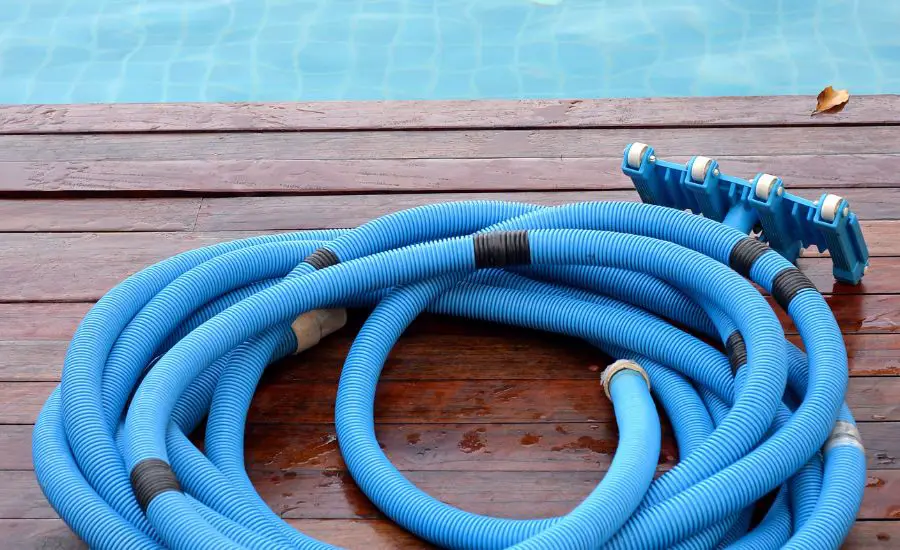
Set up the hose and attach it to the pool
To empty your above-ground pool using just a hose, you’ll need to set it up properly to ensure maximum flow and efficiency.
- Attach the hose to the pool
Attach one end of your garden hose to the pool’s inlet or suction port, often in the skimmer box or main drain. Secure it with hose clamps to prevent leaks and make sure your outdoor faucet is open for water flowing.
Run the hose to the area where you want to drain pool water, like your lawn, garden, or street. Make sure the hose is placed on a downward slope the entire way to allow for proper drainage and maximum flow. Position the end of the hose in an area that can properly absorb all the water from your above-ground swimming pool without causing any flooding.
As you allow the water to flow through the pool, you will notice air bubbles from it indicating that it is being pumped.
Once you see the bubbles disappear, you already know that the hose is filled with water.
For safety, place something heavy like a brick over the end of the hose to prevent the hose from thrashing around as the water flows out.
Opt for a larger diameter hose (1 1/2 or 2 inches) to drain a pool faster due to its higher water volume capacity. If needed, join multiple hoses using hose connectors and waterproof tape to reach your drainage area.
Expect it to take 6-12 hours to fully drain an average-sized above-ground swimming pool, depending on factors like hose diameter, slope, and water volume.
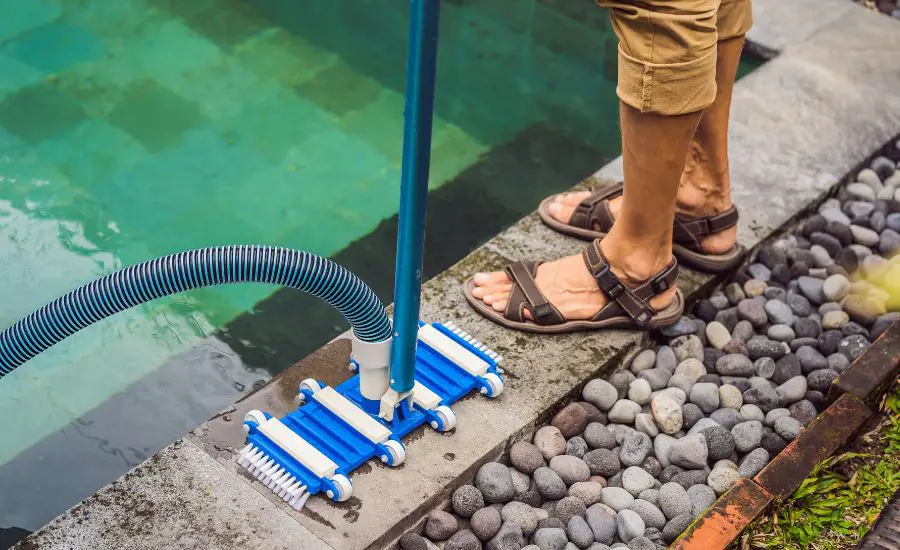
Monitor water flow and drainage
Once you’ve got your hose in place to empty the pool, you’ll need to keep a close eye on things to ensure proper flow and drainage.
- Monitor the hose
Check on your hose regularly to make sure water is flowing freely and the hose hasn’t kinked or twisted, slowing the flow. As the water level decreases, you may need to adjust the hose to keep the end submerged.
- Watch the drainage
Don’t just set the hose and forget it! Monitor the water’s drainage to ensure it’s moving toward a drainage location and not pooling near the pool’s foundation, yard, or nearby structures.
Open the valve to allow the water to flow out of the hose and into either the final container or, if you prefer, the storm drain. Some options might permit you to channel the water into the storm drains lining your street. However, be cautious if there has been significant rainfall before you begin draining your pool, as this could lead to potential overflow issues with the storm drains in your vicinity.
- Adjust flow rate
You’ll want to adjust the hose valve to control the flow of water for optimal drainage. Make small adjustments to the drain valve as needed based on how well the water is draining. Find a balanced flow that drains the pool in 6 to 12 hours.
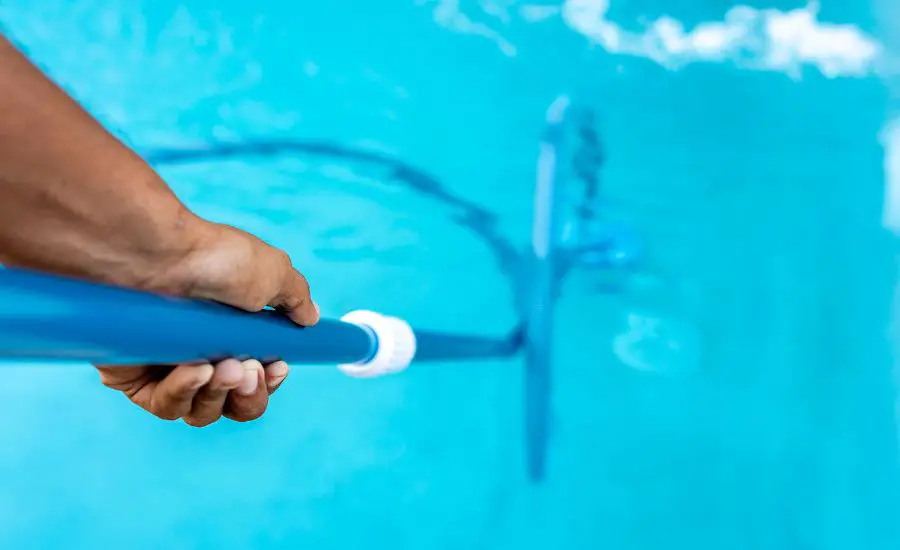
Prevent clogs and erosion
To prevent clogs and erosion while emptying your pool with a hose, there are a few key steps to keep in mind.
- Use a large-diameter hose
A standard garden hose will work to empty a pool, but it will take a very long time and risks burning out your pump. Opt for at least a 1 1⁄2 or 2-inch diameter hose to maximize flow. The larger the hose, the faster you can empty the pool.
- Place the hose in the deepest part of the pool
For efficient draining, position the hose end in the deepest part of your pool, typically the main drain. This minimizes the priming required, enabling maximum water removal. Adjust the hose as the water level decreases to keep draining from the deepest spot.
- Run the hose downhill
Run the hose from your pool pump downhill to a sewer drain, creek, ditch, or street. Gravity will help the flow out of the hose. Place the end of the hose at a lower level than the pool for the fastest emptying.
- Watch for puddles and overflow
Once the pool pump and filter have done their job draining the majority of the water from your pool, it’s time to use a garden hose to remove the remaining inches of water left on the pool floor.
Open the spigot fully for maximum flow. As the water level drops, move the hose to various pool areas for even water removal.
Once the water reaches a level of 2 to 3 inches left in the deep end, decrease the spigot flow to a trickle. The remaining water will drain slowly from the hose.
When you completely drain a pool, turn off the spigot, disconnect the hose, and store everything until next season.
Finish up and store hose
Once the pool is empty, it’s time to shut off the hose and properly store everything until the next use.
Performing maintenance on your pool as well as hot tub care easy. Before storing your equipment, check the hose for damage like tears or punctures. To remove stubborn stains, create a diy hose cleaner using equal parts water and white vinegar.
Scrub away any tough spots with an abrasive sponge or scrubber. After completing your pool repairs and maintenance, you’ll be ready to fill your pool and hot tub with fresh water for more years of easy enjoyment.
By properly draining, cleaning, and storing your hose after each use, you’ll help maximize its lifespan and ensure it’s ready to go for the next pool season.
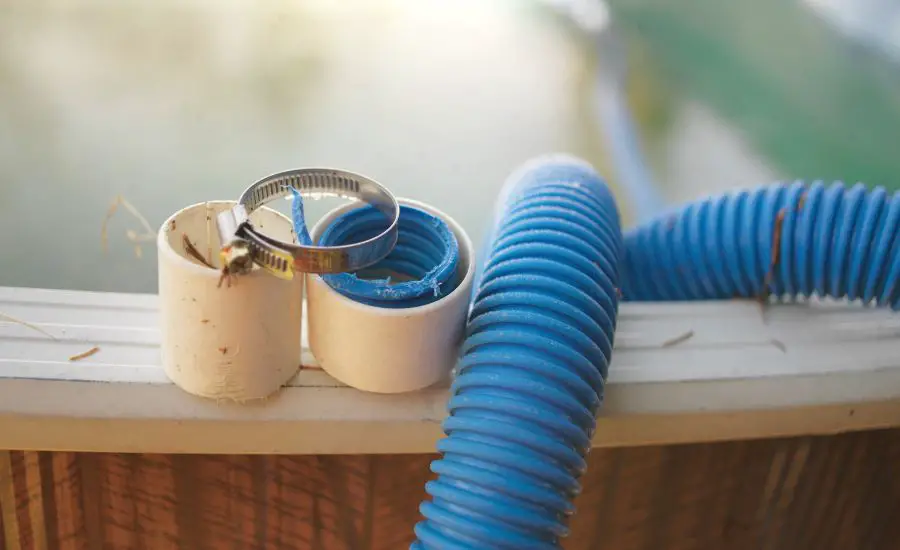
Conclusion
So there you have it, a simple diy guide to emptying your pool with a garden. Just get your garden hose, attach it to your spigot, put the other end in the pool’s main drain or skimmer, and turn on the water. The siphon effect will kick in and start emptying your pool in no time.
All you have to do is monitor the hose and water to ensure there are no kinks or obstructions. Before you know it, your pool will be emptied and ready for pool repairs or cleaning.
FAQs
This will depend on the size of your pool and the diameter of your hose. For example, draining an average-sized in-ground pool (around 15,000-20,000 gallons) with a standard 5/8-inch garden hose will take 6-12 hours.
Optimal draining locations include storm drain or sewer on your property. Avoid draining onto neighboring properties or septic systems. If options are limited, pump out water during draining to prevent flooding.
If you winterize pumps, filters, heaters, and chlorinators correctly after draining, you should encounter no problems. To prevent damage from freezing temperatures, arrange for a pool professional to blow out and winterize your equipment.
Refilling the pool involves reversing the draining process. Simply connect your hose, turn on the water, and regularly check for leaks. Be mindful not to overfill and note that refilling usually takes as long as draining. You should not have to replace your pool water completely very often if you maintain your pool chemicals and PH levels properly.
The most efficient method to empty a swimming pool involves using a sump pump.
Here’s a step-by-step guide:
Place the sump pump at the deepest part of the pool, which is usually the center of the pool floor. This ensures maximum drainage.
Connect the sump pump to a suitable drainage area, ensuring it’s a location where the excess water won’t cause any issues.
Once everything is set up, turn your sump pump on. It will begin to drain the water from your pool.
Monitor the sump pump while it’s functioning. The sump pump must stay submerged in water to prevent overheating.
When the water level is too low for the sump pump to work effectively, a wet-dry vacuum can be used to remove the remaining water.
Yes, you can siphon water with a garden hose. Simply submerge one end of the hose in the water, and place the other end at a lower level in your designated drainage area. Then, start the siphoning process by suctioning water from the drainage end until water flows freely.
To siphon water out of a pool with a hose, submerge one end of the hose in the pool and place the other end at a lower level in your drainage area. Start the siphon by suctioning water from the drainage end until it flows freely.

